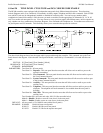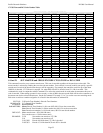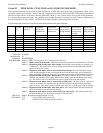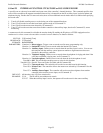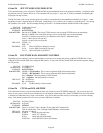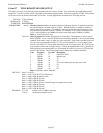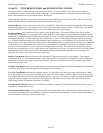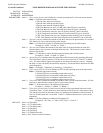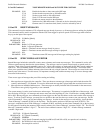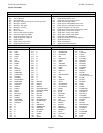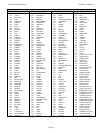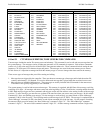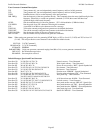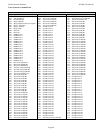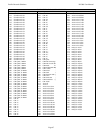
Pacific Research Solutions RI-300e User Manual
Page 60
S-Cmd 28 Continued TONE REMOTE MODE and NOTCH FILTER CONTROL
EXAMPLE: 28 0 1 Enable the decoder to detect tone on the RX input
27 1 8 Set the decoder response time to 180 milliseconds
27 2 5 Set the no tone timer to 110 milliseconds
28 3 1 Notch 2175 Hz tone from the RX input
28 4 1 Enable tone remote encode to the transmitter
28 5 10 Send tones for 1000 milliseconds (1 Second) at device selected by item 0
28 6 3 Generate tone 3 for tone burst time (item 4) at device selected by item 0
S-Cmd 29 RESET MESSAGES
This command is used to terminate a CW or Speech message already in process, or all messages that are waiting for playback.
This command could be used in conjunction with the COS event trigger to quiet all speech or CW messages when someone
keys up on the input of the repeater.
SYNTAX: 29 [Buffer] [Mode]
READ BACK: N/A
STORAGE: N/A
PARAMETERS: Buffer 0 = CW tone generator,
Buffer 1 = Speech Synthesizer
Mode 0 = Terminate current message already in process
Mode 1 = Terminate current and all messages waiting for playback
DEFAULT: N/A
EXAMPLE: 29 0 1 Terminate current CW message and all messages waiting for playback
S-Cmd 30 SPEECH MESSAGE EDITOR
Speech Messages include the station ID, courtesy tones, telemetry and custom user messages. This command is used to edit
and store speech message data into the system memory. The messages consist of speech control words or speech words in
sequence. Each of these speech commands consists of a 3-digit value and they are used to tell the RI-300’s speech synthesizer
what to do. These commands include 32 control words, a 661-word vocabulary and 50 DVR messages. The control words
allow you to speak the time, S-Meter and many other items with only a single command. The messages are stored in the same
memory area as the macros. For this reason, it is important to manage and track the memory usage so as not to damage other
data stored in the memory.
There are two types of messages that you will be creating and editing.
1. Messages that are triggered by the controller. These are the most common type of messages and include the station ID,
courtesy and telemetry. S-Command 32 is used to define each message that is played when the associated event occurs.
2. Messages that are imbedded within macros. These messages are usually included with S-Commands in the same macro.
These macros are typically triggered by a user command.
The system memory is used to store both macros and messages. The memory is organized with 999 lines of data storage, each
line consisting of 24 digits. All messages and macros must start at the beginning of a line. Each line has a starting number from
001 to 999. Message triggers, user commands and event triggers use the start line address as the start location of the message or
macro. To edit or create a message, you must first set a pointer to the start line where you want to start your message. Do this
with S-Command 63. Next, you can start building your message. In order for the message to work correctly, it must include a
“Start of Message” command (30 001) as the first entry. The next entries are those of the message itself (30 XXX). The
message is completed with an “End of Message” command (30 002), and finally an end of data command: (64) as the last entry.
For the purpose of tracking the amount of digits stored in memory, the “Start of Message” consumes 2 digits “30”. The “End of
Message” command consumes 1 digit “C”. The end of data command consumes 1 digit “D”. All other message commands
consume 3 digits each.
SYNTAX: 30 [Speech Command]
READ BACK: 30 * [Speech Command]
STORAGE: EEPROM
PARAMETERS: 3 digit Speech Commands ranging from 000 to 693 and 901 to 950, see speech word vocabulary
DEFAULT: See default list in this section S-Cmd 31.
EXAMPLE: See example in section 9.



